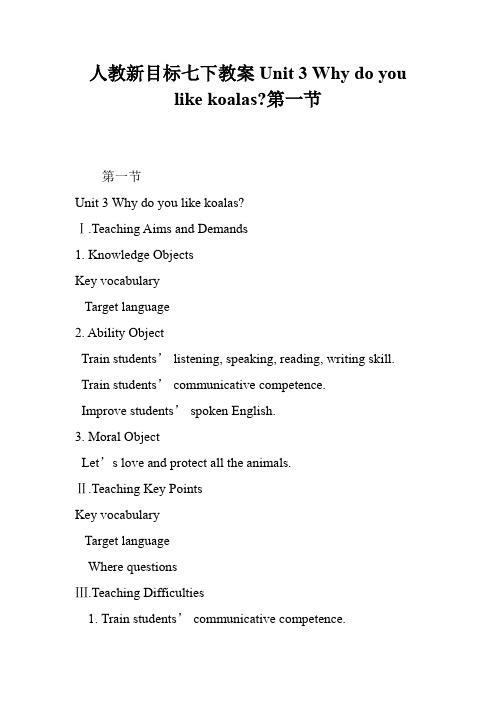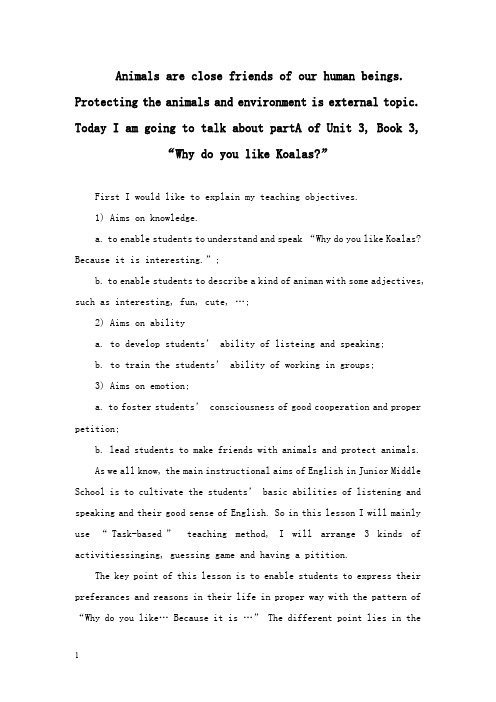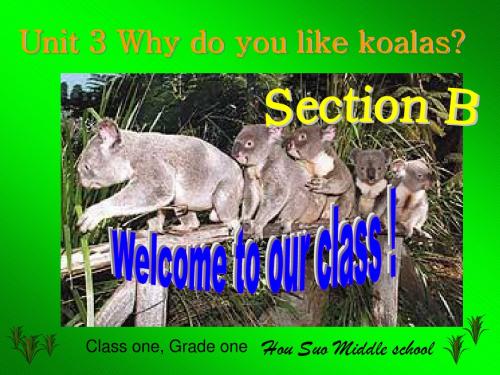新目标英语七年级下Unit 3 Why do you like koalas
- 格式:doc
- 大小:54.00 KB
- 文档页数:12

人教新目标七下教案Unit 3 Why do youlike koalas?第一节第一节Unit 3 Why do you like koalas?Ⅰ.Teaching Aims and Demands1. Knowledge ObjectsKey vocabularyTarget language2. Ability ObjectTrain students’ listening, speaking, reading, writing skill. Train students’ communicative competence.Improve students’ spoken English.3. Moral ObjectLet’s love and protect all the animals.Ⅱ.Teaching Key PointsKey vocabularyTarget languageWhere questionsⅢ.Teaching Difficulties1. Train students’ communicative competence.2. Improve students’ spoken English3. Teach students to express preference and give reasons.Ⅳ.Teaching MethodsScene teaching methodsPairworkListening and practicing methodsⅤ.Teaching AidsA tape recorderA computerA map of the worldⅥ.Teaching ProceduresStep ⅠRevisionReview how to give directions on the street.Step Ⅱ1a1. Show the pictures of the animals. Ask students to name as many animals as they can.2. Match the words with the animals in the picture.Step Ⅲ 1b 1c1. Listen to the tape carefully. Check the names of the animal s you hear.2. Look at the animals in the picture in 1a and make conversati ons about them using the words in the box.3. Ask several pairs of students to share their conversations w ith the whole class.Step Ⅳ 2a 2b(2a)1. Listen carefully and write the animals you hear on the lines.2. Check the answers.(2b)3. Play the same recording once again. Complete the con versation with the words in the box.4. Go over the answers.Step Ⅴ 2cWork in pairs. Make conversations like the one using the wo rds in the box.Ask several pairs of students to act out their conversations. Step Ⅵ Grammar FocusRemind students the difference of kind of and very. Get stu dents to made sentences to get a further understanding.Step Ⅶ 3a1. Look at the map of the word. Named China, Australia and South Africa. Have students repeat several times.2. Match the animals and the countries they’re from.3. Go over the answers.Step Ⅷ 3b1. Work with a partner. Make conversations similar to the sa mple one using the animals and countries in 3a.2. Ask several pairs of students to act out their conversation s.Step Ⅸ 41. Point to the word box. Go over the names of countries and animals.2. Listen carefully and cross out the words you hear.3. Check the answers by replaying the tape.Step Ⅹ SummarySummary the target language we’ve learned in this lesson. Step Ⅺ HomeworkWrite five sentences about the animals you like or you don ’t like. Use because to show the reason.Blackboard DesignUnit 3 Why do you like koalas?Why do you want to see the lines?Because they’re cute.Where are they the lines from?They’re from Africa.。

Unit3 Why do you like koala bears? 第一课时教学设计吉林省第二实验学校张建丽教学设计吉林省第二实验学校张建丽一、教学设计说明根据新课程的要求,英语课堂要注重以学生的学为主体,创设宽松的课堂氛围。
所以要让学生直接参与探求知识,解决问题的全过程,以确定学生的主体地位,力求在完成课程教学目标和要求的前提下,培养学生自主学习的能力及敢于创新的精神二、教学分析1.教学内容分析Unit3 Why do you like koala bears? 是人教版《新目标英语》七年级下册第三单元,是一个复习单元,也是一个承上启下的单元。
本单元谈论的话题是动物,话题是新的,但基本句型都是学过的。
所以对学生来说并不陌生,难度也不大,但是本单元句型相对单一、语言框架也相对单薄。
所以应重视学生的实际需要,摆脱对固定教材的依赖,通过合理的设计引导学生对此话题展开更充分的讨论。
通过本单元的学习,学生应能较流利地运用所学词汇和句型描述动物,表达个人喜好。
2.教学对象分析本单元的授课对象是一群活跃、有好奇心、乐于探索的初中一年级学生。
从初一学生特点来看:他们处于英语学习的初级阶段,词汇量和英语知识的储备还很有限,但他们想象力丰富、思维活跃,所以通过视听、读说和表演等多种方式加强语言的输入。
同时针对不同类型的学生的特点,创设不同的学习情境,争取让每位同学都能在课堂上找到参与学习的快乐和满足感。
三、教学目标1.知识与技能目标1)学生能够理解和掌握英语中表示动物的单词,有koala,tiger,elephant,dolphin,panda,lion, penguin,giraffe, zoo, map, first, cute, fun, smart,animal, kind2)会用一些形容词来描述不同的动物。
3)同时教会学生表达自己或别人的喜好并陈述原因。
2.过程与方法目标1)充分利用教学图片和多媒体,创设情景让学生有参与学习的欲望,引导学生积极参与课堂活动,成为教与学的主体。

班级 姓名 考场 考号 座位号 号-------------------------○密--------------------------------------○封------------------------------------○线----------------------※※※※※※※※※※※※答※※※※※※※※※※※※※※※※※※题※※※※※※※※※※※※※※※※※线※※※※※※※※※※Unit 3 Why do you like koalas?讲解与练习讲解 一、词组1.like to do sth / like doing sth 喜欢做某事2.play with … 与...一起玩3.be quiet 安静4.during the day 在白天5.at night 在夜间6.eat grass 吃草7.eat leaves 吃树叶8.very shy/ smart/ cute 非常害羞/聪明/可爱9.South Africa 南非 10.other animals 其他动物 二、日常交际用语(1)-Let’s see the lions frist.咱们先看看狮子吧。
(Let’s do…first.咱们先做……。
其中Let’s 是let us 的缩写形式,意思是―让我们、咱们……‖,一般用来提出建议,后接动词原形。
其中first 是副词,意为―首先‖表示顺序,其位置可置于句尾,也可置于句首。
) Eg:-Let us play games. –Great! -Let me see.(2)-Do you like giraffes?你喜欢长颈鹿吗? Yes,I do.是的,我喜欢。
/ No,I don’t.不,我不喜欢。
(Do you like+n.?你喜欢……吗?其中名词可为不可数,也可为可数,当是可数名词时要用它的复数形式。
) (3)-Why do you want to see the lions?你为什么想去看狮子呢? -Because they are very cute.因为他们逗人喜爱。

Animals are close friends of our human beings. Protecting the animals and environment is external topic. Today I am going to talk about partA of Unit 3, Book 3,“Why do you like Koalas?”First I would like to explain my teaching objectives.1) Aims on knowledge.a. to enable students to understand and speak “Why do you like Koalas? Because it is interesting.”;b. to enable students to describe a kind of animan with some adjectives, such as interesting, fun, cute, …;2) Aims on abilitya. to develop students’ ability of listeing and speaking;b. to train the students’ ability of working in groups;3) Aims on emotion;a. to foster students’ consciousness of good cooperation and proper petition;b. lead students to make friends with animals and protect animals.As we all know, the main instructional aims of English in Junior Middle School is to cultivate the students’ basic abilities of listening and speaking and their good sense of English. So in this lesson I will mainly use “Task-based”teaching method, I will arrange 3 kinds of activitiessinging, guessing game and having a pitition.The key point of this lesson is to enable students to express their preferances and reasons in their life in proper way with the pattern of “Why do you like… Because it is …” The different point lies in thewriting part. Students are required to write some sentences to describe a kind of animal. Before the task, some useful adjectives will be provided to help students express freely.Now I will specify my teaching procedures.Step 1 warming-up1) free talk between teacher and students about their pets and their experience of visting the zoo. It provide situation to review learned knowledge for the next step;2) sing the song together “going to the zoo”It is important to form a good English atmosphere for students by singing.Step 2 presentation1) Listening to an video about the voices of different kinds of animals and let students write the names of animal they hear;2) Show a picture of a zoo and let students say the names of animal they can see in the picture;Step 3practice1) Students work in pair to talk about their favourite animals using the pattern “I want to see… why do you like…,because it is…”;2)playing a guessing gameDivide the whole class into four groups to have a petitin. The teacher read a sentence to describe a kind of animal each time and students guess what it is as quickly as they can according to the information given by teacher. The group who can get the right answer in the shortest time will be winner.All the students try to write 5-6 sentences to describe a kind of animal that they are familiar with, This is an individual work. Then onestudent of a group of four members read his /her description and the other members guess what the animal is . The members take turn to plete the task.Homework;Ask students to write a position“My pet or my favourite animal ”。


Unit 3 Why do you like koalasLanguage goalsIn this unit students learn to describe animals and express preferences and give reasons,New languageWhy do you like koala bears?. Because they're cute,They're pretty interesting, They're kind of shy, They're very big.names of animals such as tiger, elephant, koala bear, dolphindescription words such as smart, cute, intelligentnames of countries: Australia, South Africa,Recycled languag ebetween, across fromHe's/She's from ... He's / She's five years old.name of countries; China, Japan, BrazilSection AAdditional materials to bring to class:coins or other markers for the Bingo game in 4.Ask students to name as many animals as they can in English. Write the list on the board,Ask students to describe each animal in some way.They may tell its color or tell if it is big or small.Say, Today we are going to learn the names of some more animals. Well also leam how to say which ones we like and tell why we like them.la This activity introduces the key vocabulary.Focus attention on the map of the zoo showing pictures of animals. Ask students to point to and name any animals they can.Point to the animals one by one and say the name of each. Ask students to repeal.Point out the numbered list of words. Say each one and ask students to repeat.Then ask students to match each word with one of the pictures. Say, Write the letter of each animal in the blank by that animal's name. Point out the sample answer. Check the answers.1 b This activity gives students practice in understanding the target language in spoken conversation.Point to the animals in 1a- Ask students to point to and name the animals.Say, I'm going to play recordings of three conversations. Listen carefully as you look at the words in la.Put a checkmark in front of the name of each animal you hear.Play the recording the first time. Students only listen.Play the recording a second time. This time students check each animal name they hear.Correct the answers.1 c This activity provides guided oral practice using the target language.Call attention to the example conversation in the picture. Ask two students to read it to the class. Answer any questions they may have.Point out the four description words. Ask a student to read them aloud. Review the meaning of each word.Say, Now you can make conversations about animals.Your conversations can be like the example. Use these description words.Ask students to work in pairs. Have them take turns saying both parts.If students need help getting started, demonstrate another conversation with a student. For example:Teacher: let's see the elephant.Student: Why do you want to see the elephant?Teacher: Because it's very smart.Ask some students to present their conversations to the class.2a This activity provides listening practice using the target language.Call attention to the two blank lines on the left. Say,You will hear a recording of aconversation. Listen carefully. Then write the names of the two animals you hear on these lines.Play the recording the first time. Students only listen.Play the recording a second time.This time students write in the names of the animals.Check the answers.Point out the adjectives listed on the right. Ask a student to say the words.Say, Now I will play the recording again. This time draw a line between each animal and the adjective you hear.Play the recording and have students match each animal with an adjective. Correct the answers.2b This activity provides listening and writing practice using the target language.Call attention to the conversation and the blank lines in it Say, You will hear the recording again. This time please write a word from the box on each blank line.Some words can be used more than one time.Ask a student to read the words in the box.Play the recording. Check to see that students are writing a word from the box on each line of the conversation.Go over the answers.2c This activity provides guided oral practice using the target language.Call attention to the conversation in the picture. Ask two students to read it to the class.Say, Now you can have conversations like this e the words in Box 1, Box 2, and Box 3 in your conversations.Demonstrate a conversation with a student. For example:Student: Do you like penguins?Teacher: Yes, I do.Student: Why?Teacher: Because they're very cute.3a This activity provides reading practice using the target language.Point to and say the names of the three countries on the maps and ask students to repeatPoint to the three animals and ask a student to name them.Say, Now draw a line between each animal and the country it comes from. Correct the answers.3b This activity provides guided oral practice using the target language.Point to the conversation in the picture.Ask a pair of students to read it to the class.Ask students to work in pairs. Say, Now you can talk about where animals come from. Point to the map and animals students matched up in 3a-Say, Work with a partner. Take turns asking and answering questions about the countries and animals in 3a.After a few minutes, ask several pairs to say the conversation for the class. Section BAdditional materials to bring to class:Pictures of household pets and zoo animals cut out of magazines for Follow-up activity 1.1This activity introduces more key vocabulary,Call attention to the animals in the picture and ask a student to say the name of each one.Point out the list of eight numbered adjectives at the top.Say, Now please match the adjectives at the top with the animals in the picture.Write the letter of the animal on the line after the adjective. Point out the sample answer.As students work, move around the room offering to answer questions as needed. Correct the answers-2a This activity provides listening practice with the target language.Say, Now I will play a recording of a conversation between Tony and Maria. This time circle the adjectives you bear on the list for la.Play the recording again. Students circle the adjectives they hear.Correct the answers.2b This activity provides listening and writing practice using the target language.Call attention to the three headings. Animal, Maria's Words and Tony's Words, and the write-on lines under each.Say, Now I will play the recording again. This time please write the name of the animals each person talks about and the words they say.Play the first four lines of recording and stop the tape. Ask, What animal are they talking about? (the elephant) What words does Maria use to describe the elephant?(interesting, intelligent)Point out the write-on lines where students can write these words.Play the whole recording and have students write the words they hear on the chart. Check the answers.3This activity provides guided oral practice using the target language.Call attention to the dialogue next to the picture. Ask two students to read it to the class.Say, Work in pairs. Use sentences like these to say what you think about different animals.Demonstrate the activity with one or two students. For example, say, I like dolphins.They're intelligent.Ask students to work in pairs. As they work, move around the room checking on progress.Ask some pairs to present their conversations to the class.3a This activity provides reading practice using the target language.Point out the three descriptions of animals. Ask students to take turns reading one aloud.Then draw attention to the pictures of animals below.Say, Write the letter of the animal in the blank lines above its description. There is one animal that is not described.Check the answers.3b This activity introduces some new vocabulary words and provides reading and writing practice using the target vocabulary.Call attention to the pictures of animals in 3a, and draw attention to the grass, leaves, and meat. Ask a student to explain each word or use it in a sentence to show he or she understands what it means. Teach the expression sleeps.Point out the description in 3b with blank lines where some words are missing.Read it to the class saying blank each time you come to a blank line.Point out the six words in the box. Say, You can write these words in the blanks.Use each word only once.As students work, move around the room checking progress and offering language support as needed.Check the answers.3c This activity provides reading and writing practice using the target language, Say, Now you can write a description like the one in 3b. You can use some of the same words. Write about any animal you like.You may wish to do a sample description with the class. Choose an animal's name and write it on the board. Then ask students to make statements about the animal.Repeat each statement and then write on the board. You can ask leading questions such as. Is it big? Is it lazy? Does it eat grass?Ask students to write their own descriptions. You may wish to have less fluent students work with a more fluent partner,Ask students to share their writing with others in the class.After you have reviewed the students' work, you may wish to have some students recopy their work so that you can post it on the classroom bulletin hoard.。
Unit 3 Why do you like koalas?一、教学内容:Unit 3 Why do you like koalas?(一)语言功能:Describe animals; Express preferences描述动物;表达好恶(二)目标语言:1. What animals do you like? I like elephants.2. Why do you like pandas? Because they’re very cute/interesting/s mart.3. Where are lions from? Lions are from South Africa.4. She is very beautiful but she is very shy.(三)重点单词和词组1. first num.第一This class we are going to learn the first lesson. 今天我们学习第一课。
adv. 首先,最初。
用作状语,修饰动词或句子。
Let the old man go first. 让老人先走。
adj. 最初的,首先的The first thing to us is to learn English well.对我们来说首要的事是学好英语。
2.(1)kind 常用作名词,表示“种,类”表示一个种类的用kind of +名词,名词一般用单数,名词前不加冠词.—What kind of movie do you like? —I like action movies.—你喜欢哪种电影?—动作片。
What kind of fruit do you want? 你想要哪种水果?a kind of 一种all kinds of 各种各样的many kinds of 很多种类的different kinds of 不同种类的(2)kind 用作形容词,表示亲切的,和蔼的The teacher is very kind to us. 老师对我们很好。
Unit3 Why do you like koalas? 教学案例分析一、设计理念:在新课程理念下的英语课堂教学应是“以学生发展为中心,师生共同参与教学活动,全面建设交流为主体的新型师生关系,重视学习方式转变,着重培养学生的创新精神,和实践能力,实现个性化,多元化的课堂教学。
”根据这一理念,我在设计本课的教学活动时,充分遵循了“学生互动,师生互动”的原则。
选择有利于师生角色互换,现场表演等活动。
二、教材分析:本课来源于九年义务教育(实验本)《新目标》七年级下册,第三单元“Why do you like koalas ? ”。
这一话题,对初一学生而言,很贴近生活,所以通过合理的教学设计引导学生对此展开充分的讨论。
通过对动物的描述,使学生学会表达喜好并陈述原因;学会运用why, what, where引导的问句,了解动物的外形、生活习性及主要产地,并能运用英语简单描述自己喜欢的动物。
进一步培养和激发学生热爱动物、保护动物、维护生态平衡的朴素情怀。
本单元,对学生而言即是新知,又有一定的基础和生活体验,因此,本人以此为基础,借题发挥,进一步深入,开展一节外语活动课教学。
三、学情分析:1.学生特点从我校初一学生的特点来看,他们外语基础薄弱,学习外语兴趣不浓,而且尚处于外语初步学习阶段,因此要充分利用各种教育资源,多媒体教学手段,通过视,听,表演,说,写等多种教学策略给学生输入可理解的语言,锻炼他们的英语思维,丰富英语词汇的存储,促进语言的实际应用和表达。
尤其要激发学生学习英语的兴趣。
2.知识结构学生此前已经学过由why, where, what 引导的特殊疑问句句型,具有了学习本单元知识的认知前提。
形形色色的动物能激发学生的好奇心,产生了解它们的欲望,这有利于本单元知识的教学和学生学习兴趣的培养。
四、教学目标:1.知识与技能目标:学生学会描述动物并表达喜好,给出原因。
2.过程与方法目标:培养小组合作意识,注重自主学习策略的培养。
新目标七年级英语下册Unit3 h d u liealas?教案教案正文随堂记录Unit3hduliealas?I语言知识目标1把握以下有关动物的名词:tigerelephantaladlphinpandalinpenguingiraffe2有关品质的形容词:utesartshuglleverbeautifulfriendlquietlaz3有关国家的名词:AfriaapanAustralia4其他词类:grassleafeatsleeprelaxindf᠖把握以下句型使学生熟练谈论自己喜爱的动物并给出理由。
使学生学谈论自己喜爱的其他东西并给出理由。
使学生了解动物的生存情形。
II语言能力目标1使学生熟练谈论自己喜爱的动物并给出理由。
2使学生学谈论自己喜爱的其他东西并给出理由。
3使学生了解动物的生存情形。
III情感目标1通过学习要培育学生自觉爱惜动物的意识。
2通过学习能够使学生加倍酷爱生活。
酷爱父母、酷爱朋友,酷爱自然。
3能在小组活动中踊跃与他人合作,彼此帮忙。
IV教学重点难点1重点把握动物单词的表达法,及谈论自己最喜爱的动物的表达法。
把握动物特点的形容词,并能谈论喜爱某一种动物的缘故。
把握介绍来历的表达法。
2难点表达动物的的意义和读音。
indf用法。
如何用所学句型进行综合运用。
V任务特点一、学生学会如何谈论自己所喜爱的动物及缘故,具有实际交际能力,符合中学生交往的原那么,二、由喜爱动物到喜爱各类各样的东西,学生能激发内心的爱心,加倍酷爱生活,爱惜自然。
3、了解父母朋友同窗的各类爱好,更能激发学生的友谊、亲情,更多的每一个人。
VI教学步骤教案正文随堂记录PeridI1Tpihdulie…2Strutinhduliealas?Beausethearever/indfute3TasTalabu turfavriteanial4ulturensethingabuttheanialsintherldVa bularanial,ala,elephant,dlphin,lin,tiger,panda,dg,pengu in,ver,indf,ute6Graarhduliealas?Beausethearever/indfu te能力目标:通过学习句型,学生能谈论,询问所喜爱的动物和缘故。
新目标英语七年级下Unit 3 Why do you like koalas
单元说课教案
一、学生分析
七年级学生爱动,求知欲强,接受能力较强。
经过中学上学期半年的任务型课堂的熏陶,他们对课堂上的英语活动已经习惯,要求参与课堂英语活动的热情很高,课堂表现活跃。
他们基本上能够接受大密度的语言输入和语言输出的课堂授课模式。
课堂上,他们也能够进行多人合作学习。
但是,每个班都还有少数几个学生在小学阶段没有学过英语,他们的课堂学习效果显得不是很理想。
要面向每一个学习个体,让每一个后进生跟上我们的教学是我课堂教学追求的一个重要方向。
因此,在教完这个单元后,我针对所教两个班级学生的学习现状设计了这节复习课。
二、教材分析
本课是本单元的一个复习课。
课前学生已经学完本单元的所有教学内容,但考虑到少数后进生还没有很好达成本单元的教学目标,同时为了给学生创设一个更轻松的学习氛围,我设计了这节复习课。
三、教学目标
(一)语言知识目标
1.掌握下列单词
(1)关动有物的名词:tiger ,elephant, koala, dolphin, panda, lion, penguin, giraffe
(2)有关品质的形容词:cute, smart, shy, ugly, clever, beautiful, friendly, quiet, lazy
(3)有关国家的名词:Africa, Japan, Australia
(4)其他词类:grass, leaf, meat, sleep, relax, kind of
2.掌握下列句型
Why do you want to see the pandas?
Because they’re cute.
Why does he like the koala bears?
Because they are kind of interesting.
What animals do you like?
I like penguins. They are cute.
What other animals do you like?
I like dogs, too.
Where are lions from?
They are from Africa.
使学生熟练谈论自己喜爱的动物并给出理由。
使学生学谈论自己喜爱的其
他东西并给出理由。
使学生了解动物的生存情况。
(二)语言能力目标
1.使学生熟练谈论自己喜爱的动物并给出理由。
2.使学生学谈论自己喜爱的其他东西并给出理由。
3.使学生了解动物的生存情况。
(三)情感目标
1.通过学习要培养学生自觉保护动物的意识。
2.通过学习可以使学生更加热爱生活。
热爱父母、热爱朋友,热爱自然。
3.能在小组活动中积极与他人合作,相互帮助。
(四)教学重点难点
1.重点:
(1)掌握动物单词的表达法,及谈论自己最喜欢的动
物的表达法。
(2)掌握动物特点的形容词,并能谈论喜欢某一种动
物的原因。
(3)掌握介绍来历的表达法。
2.难点:
(1)表达动物的的意义和读音。
(2)Kind of 用法。
(3)如何用所学句型进行综合运用。
(五)任务特点
1.学生学会如何谈论自己所喜欢的动物及原因,具有实际交际能力,符合
中学生交往的原则,
2.由喜欢动物到喜欢各种各样的东西,学生能激发内心的爱心,更加热爱生
活,保护自然。
3.了解父母朋友同学的各种爱好,更能激发学生的友谊、亲情,更多地去关
心身边的每一个人。
(六)教学向导
四、教学策略
1.本课主要运用“任务型教学法”,并辅助以情景交际教学法和猜谜活动。
(1)任务型语言教学法
任务型语言教学是交际语言教学近年来发展起来的一种教学方法,主张采用任务型语言教学的人认为:人们使用语言的过程就是一个完成各种各样任务的过程。
在本课的任务型语言教学中,我将依据课程的总体目标并结合教学内容,创造性地设计贴近学生实际的任务活动,吸引和组织他们积极参与,使学生通过观察、思考、讨论、交流和合作等方式,在一种自然、真实或模拟真实的情境中体会语言、掌握语言的应用。
(2)情景交际法
课堂教学以情景交际教学法为主,尽量给学生以足够的听、说、读的机会,联系课文实际,创设情景,引入讨论主题,在交际中学英语。
情景的设计注意衔接的自然性,主题的设计强调知识的渐进性和讨论的可行性,并注意情感体验和概括、推理思维的培养。
2.学法指导
(1)合作学习:合作学习是指学生通过分工合作共同达成学习目标的一种学习方式。
本节课将在课堂活动中把学生分成四人一小组的学习小组,让他们围绕着课堂任务分工合作,在活动中相互探讨、相互交流、相互合作、相互补充,从而获得知识、技能和情感体验,发展他们的能力。
(2)创设情景和有意义的任务活动,激发学生的学习热情,培养他们的概括和推理能力,发挥他们自己的主观能动性,把被动的学习变为主动学习。
3. 课前准备
(1)教师准备:
图片、课件、网上英语歌曲
(2)学生准备:
预习生词和课文
五、教学过程
六、课后反思
本课能够通过一系列前后关联的活动,环环相扣地推进教学目标,逐步突破本课的教学重难点。
本课最成功之处有:(1)Bingo 游戏充分有效地调动了每一个学生参与到课堂教学重来了,就是那些基础最差的一、两个后进生也饶有兴趣地参与到激烈的游戏中来了。
(2)英语演讲在这个环节里,那些语言能力和基础较好的学生能抓住这个机会在课堂上充分表现自己的英语能力和知识
面(关于动物的知识),有的学生的演讲稿写得有板有眼,语言较规范,格式较正确,描述性的词语用的较灵活。
(3)任务后活动学生在修改他们和别人演讲辞中的语言表达错误的同时也能认识到自己书面表达中的类似语言错误,本人认为这样的活动对弥补现在我们课堂教学中的尴尬问题很有价值。
我们现在的英语课堂,往往是课上师生活动轰轰烈烈,一旦让他们动手书面表达的时候却错误百出。
这个问题曾经苦恼过我很久,这段时间(包括这堂课上)的进行的这方面的探索让我觉得这个任务后活动对解决这个问题很有价值!以上活动的设计都是依据“任务型教学”理念设计的。
这种教学理念就是要求我们新课程实施者在课堂设计和教学中,结合课标要求,通过设计一些贴近学生生活的活动,让学生用英语去做事,让他们在做事中感受语言,习得语言,提高能力,发展情致,开拓他们的想象力和创造力。
本课要调整和改进的方面是,课件里面的动物图片的动画效果还不是很理想。
七、课例评析
本课以说写为主线,最后的中心任务也落实在写。
首先以听和看引入,接着从看图说话引入读写,在读的过程中适当穿插说,既练习口头表达,又巩固了读的成效。
最后,本课的中心任务选自于学生目前很感兴趣的动物,即是任务,又象游戏,最后的展示是以演讲辞的形式,课后活动让学生修改自己的演讲辞并上交到教师处再次评改,便于师生共同落实本课的写的任务。